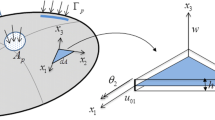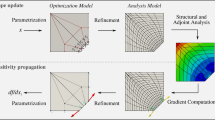Abstract
A generalized sensitivity formulation described in a curvilinear coordinate system is proposed. Utilizing it, the continuum-based isogeometric shape sensitivity analysis method for the shell components is developed in the curvilinear coordinates derived from the given NURBS geometry. In isogeometric approach, the designs are embedded into the NURBS basis functions and the control points so that geometrically exact shell models can be incorporated in both response and sensitivity analyses. The precise shape sensitivities can be obtained by considering accurate and continuous normal and curvatures in the boundary integrals of the boundary resultants of the shell and their material derivatives. Through numerical examples, the developed isogeometric shape sensitivity is verified to demonstrate excellent agreements with finite difference sensitivity. Also, the importance of higher order geometric information in the sensitivity expressions is identified. For the shape optimization problem of the shell, the proposed method works well with boundary resultants accompanying severe curvature changes.












Similar content being viewed by others
References
Ahmad S, Orons BM, Zienkiewicz OC (1970) Analysis of thick and thin shell structures by curved finite elements. Int J Numer Meth Eng 2:419–451
Ansola R, Canales J, Tárrago JA, Rasmussen J (2002) An integrated approach for shape and topology optimization of shell structures. Comput Methods Appl Mech Eng 80:447–458
Benson DJ, Bazilevs Y, Hsu MC, Hughes TJR (2010) Isogeometric shell analysis: the Reissner-Mindlin shell. Comput Methods Appl Mech Eng 199:276–289
Bletzinger KU, Ramm E (2001) Structural optimization and form finding of light weight structures. Comput Struct 79:2053–2062
Bletzinger KU, Firl M, Linhard J, Wüchner R (2010) Optimal shapes of mechanically motivated surfaces. Comput Methods Appl Mech Eng 199:324–333
Bouclier R, Elguedj T, Combescure A (2013) Efficient isogeometric NURBS-based solid-shell elements: mixed formulation and B-method. Comput Methods Appl Mech Eng 267:86–110
Cho S, Ha SH (2009) Isogeometric shape design optimization: exact geometry and enhanced sensitivity. Struct Multidiscip Optim 38:53–70
Cottrell JA, Reali A, Bazilevs Y, Hughes TJR (2006) Isogeometric analysis of structural vibrations. Comput Methods Appl Mech Eng 195:5257–5296
Cottrell JA, Hughes TJR, Reali A (2007) Studies of refinement and continuity in isogeometric structural analysis. Comput Methods Appl Mech Eng 196:264–275
Echter R, Oesterle B, Bischoff M (2013) A hierarchic family of isogeometric shell finite elements. Comput Methods Appl Mech Eng 254:170–180
Espath LFR, Linn RV, Awruch AM (2011) Shape optimization of shell structures based on NURBS description using automatic differentiation. Int J Numer Methods Eng 88:613–636
Farin G (2002) Curves and surfaces for CAGD: a practical guide. Academic, New York
Fuβeder D, Simeon B, Vuong AV (2015) Fundamental aspects of shape optimization in the context of isogeometric analysis. Comput Methods Appl Mech Eng 286:313–331
Haftka RT, Grandhi RV (1986) Structural shape optimization—a survey. Comput Methods Appl Mech Eng 57:91–106
Hassani B, Tavakkoli SM, Ghasemnejad H (2013) Simultaneous shape and topology optimization of shell structures. Struct Multidiscip Optim 48:221–233
Haug EJ, Choi KK, Komkov V (1986) Design sensitivity analysis of structural systems. Academic, New York
Hinton E, Rao NVR (1993) Structural shape optimization of shells and folded plates using two-noded finite strips. Comput Struct 46(6):1055–1071
Hosseini S, Remmers JJC, Verhoosel CV, Borst R (2014) An isogeometric continuum shell element for non-linear analysis. Comput Methods Appl Mech Eng 271:1–22
Hughes TJR, Cottrell JA, Bazilevs Y (2005) Isogeometric analysis: CAD, finite elements, NURBS, exact geometry and mesh refinement. Comput Methods Appl Mech Eng 194:4135–4195
Kiendl J, Bletzinger KU, Linhard J, Wüchner R (2009) Isogeometric shell analysis with Kirchhoff-Love element. Comput Methods Appl Mech Eng 198:3902–3914
Kiendl J, Schmidt R, Wüchner R, Bletzinger KU (2014) Isogeometric shape optimization of shells using semi-analytical sensitivity analysis and sensitivity weighting. Comput Methods Appl Mech Eng 274:148–167
Naghdi PM (1963) Foundations of elastic shell theory. In: Sneddon IN (ed) Progress in solid mechanics, vol 4. North-Holland, Amsterdam
Nagy AP, Abdalla MM, Gürdal Z (2010) Isogeometric sizing and shape optimisation of beam structures. Comput Methods Appl Mech Eng 199:1216–1230
Nagy AP, Ijsselmuiden ST, Abdalla MM (2013) Isogeometric design of anisotropic shells: optimal form and material distribution. Comput Methods Appl Mech Eng 264:145–162
Piegl L, Tiller W (1997) The NURBS book (monographs in visual communication), 2nd edn. Springer, New York
Qian X (2010) Full analytical sensitivities in NURBS based isogeometric shape optimization. Comput Methods Appl Mech Eng 199:2059–2071
Rogers DF (2001) An introduction to NURBS with historical perspective. Academic, San Diego
Roh HY, Cho M (2003) Development of geometrically exact new shell elements based on general curvilinear coordinates. Comput Methods Appl Mech Eng 56(1):81–115
Simo JC, Fox DD (1989) On a stress resultant geometrically exact shell model. Part I: formulation and optimal parametrization. Comput Methods Appl Mech Eng 72:267–304
Acknowledgments
This research was supported by the National Research Foundation of Korea (NRF) grant funded by the Korea government (MSIP) (NRF-2012R1A1A1040019). The support is gratefully acknowledged.
Author information
Authors and Affiliations
Corresponding author
Appendix. Gradient computations for design sensitivity analysis
Appendix. Gradient computations for design sensitivity analysis
The unit normal vector a 3 to the other base vectors can be calculated as
Its gradient computation shown in (68) with respect to the shape parameter is given by
where
Obviously, V = V(n x) in all equations in this appendix. Also in (68), the following yields
Using a αλ a λμ = δ α μ , we have
The gradient computations shown in (77) are given by
and
Also in (79), we have
Moreover, the gradient computations of the material tensors in (80) can be given from (52),
and
Rights and permissions
About this article
Cite this article
Ha, Y.D. Generalized isogeometric shape sensitivity analysis in curvilinear coordinate system and shape optimization of shell structures. Struct Multidisc Optim 52, 1069–1088 (2015). https://doi.org/10.1007/s00158-015-1297-x
Received:
Revised:
Accepted:
Published:
Issue Date:
DOI: https://doi.org/10.1007/s00158-015-1297-x




